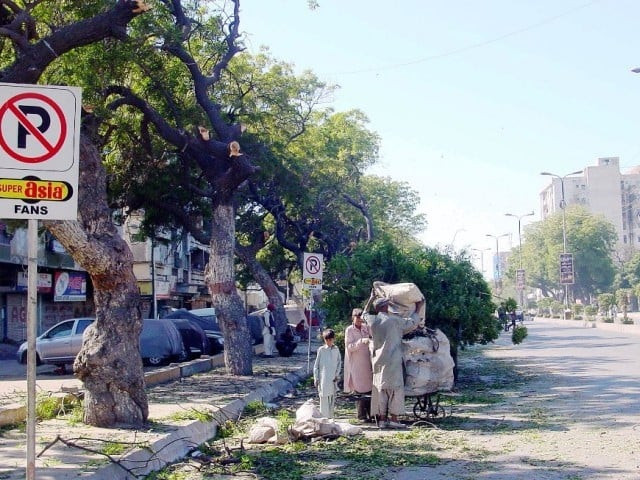Greener city: Urban forestry to counter air pollution in Karachi
Conocarpus is the wrong kind of tree for the port city, says forest expert.

Speaking to The Express Tribune, International Union for Conservation of Nature (IUCN) forest expert Syed Ghulam Qadir agrees urban forestry can be a solution to the city's air problem. "There's a direct link between the number of trees and the quality of air as trees are natural cleaners of pollutants," says Qadir, explaining that around 20% to 25% of any country or city must have trees for sustainable development.
"Sadly in Karachi, which is a concrete jungle, even parks are encroached and replaced with tall plazas," he regrets.
Being among the worst in the world, air pollution in Karachi has harmed the health of the residents and the urban economy in result. While big steps such as introducing mass transit and regulating industrial pollution must be taken, the city administration should also increase the tree cover for its obvious benefit of improving the quality of air we breathe.

While no one can deny the advantages of planting more trees, it is important to keep in mind that they emit volatile organic compounds (VOC) and cause maintenance-related pollution, which can indirectly contribute to ozone formation and pollutants. That is why planting the right kind of tree is very important.
In Karachi's case, Qadir criticises the decision to plant only one species - conocarpus - across the city instead of a variety of plants such as those found in old neighbourhoods. "These areas are full of diverse species such as neem, peepal and gulmohar among others," he points out. "These trees are indigenous and have been thriving in Karachi for many years. They are also low-maintenance and are good for the environment."
Calling conocarpus the wrong kind of tree for Karachi, Qadir shares that an earlier University of Karachi study stated the species' pollens were found in the city air in high quantity and was one of the causes for asthma. "This was when conocarpus trees were not abundantly found in the city. Imagine what would be the results if a study is done today when the city is littered with them," he says.
To have enough green spaces in Karachi to counter air pollution, Qadir says all relevant departments - land-use, water, horticulture, motor vehicles - must work together. "Allocating space for trees should be ensured during the planning phase," he says. "If you want to build everything wall to wall, then of course you will not have space for trees but that is what the regulatory authorities have to ensure," he says, adding that all such measures depend on the intent of the relevant institutions.
To maximise the impact of trees in cleaning the air, Qadir stresses they should be planted near main traffic corridors, railway tracks and highways. To cut costs, he adds, indigenous species should be planted as they require less care. "We have a shortage of water and that's why the native trees are ideal because they need water only during the starting phase. Once fully grown, they survive on their own," he explains.
While increasing tree cover is important, Qadir states it is equally crucial that the government ensure reduction in emissions, one big source of which is motor vehicles on our roads. "Introducing city-wide mass transit will be the step in the right direction," he says.
Qadir also called for mobilising the public by informing them and encouraging to plant and take care of trees. "Everyone will have to come together to clean the city's air," the IUCN forest expert stresses.
What Karachi must do
Increase the number of healthy trees to boost pollution removal
Sustain existing tree cover to maintain pollution removal levels
Maximise use of low VOC emitting trees to reduce ozone and carbon monoxide formation
Protect large, healthy trees as they have greatest per tree effects
Use low maintenance trees to reduce pollutants emissions from maintenance activities
Plant trees in polluted or heavily populated areas to maximize tree air quality benefits
Avoid pollutant sensitive species to increase tree health
Utilize evergreen trees for particulate matter reduction as they can remove particles year-round
SOURCE: USDA FOREST SERVICE, SYRACUSE, NY
Urban forests around the world
London’s 8.4 million trees of diverse species remove 2,241 tonnes of air pollution every year
The 3.5 million trees in Chicago remove some 888 tonnes of air pollution annually - a service valued at $6.4 million
Barcelona, with its 25% tree cover, has 305 tonnes of air pollution removed annually
Toronto’s 10.2 million trees store one million tonnes of carbon in them
SOURCE: FORESTRY.GOV.UK/TELEGRAPH
Published in The Express Tribune, March 21st, 2016.

















COMMENTS
Comments are moderated and generally will be posted if they are on-topic and not abusive.
For more information, please see our Comments FAQ